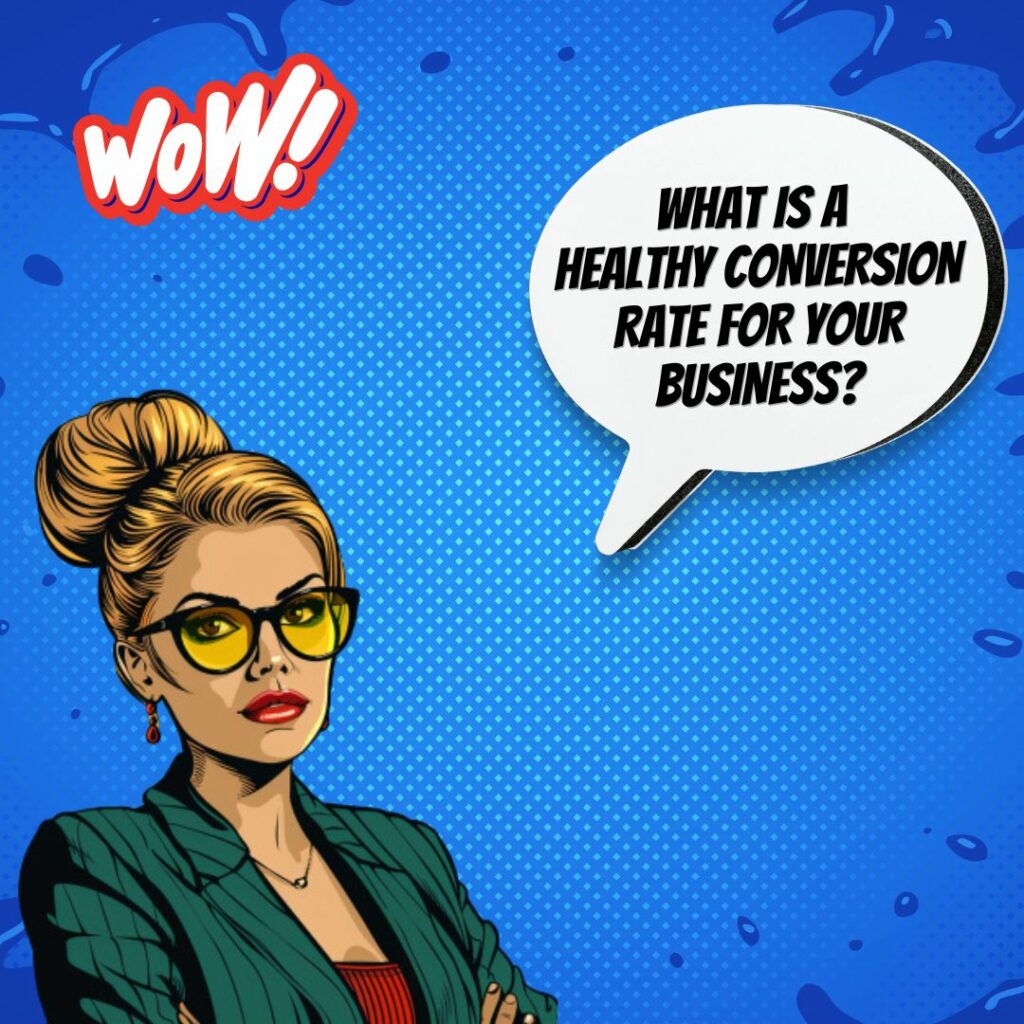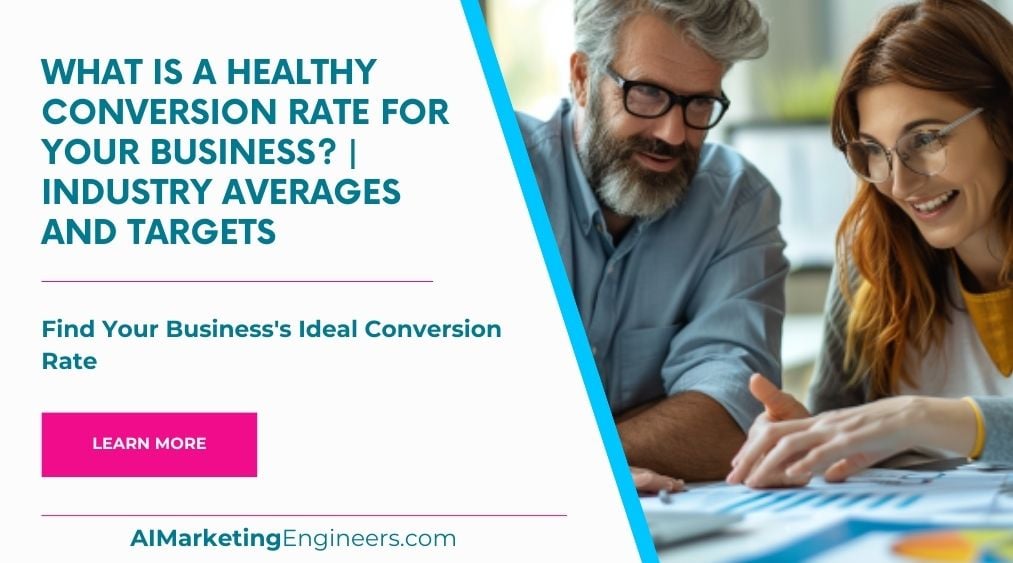Key Takeaways
✅ Industry Averages: Conversion rates can swing wildly from one industry to another. While the ecommerce world might see less than 5% as the norm, a strong sales-focused site could aim for around 10%. Across the board, 2.5% is what many consider the starting line.
✅ Target Conversion Rates: Goals vary with each venture. A general rule of thumb for website optimization could be aiming between 2-5%. If you've got a subscription box service, breathing easy around the 2% mark is common — that's over the course of a month.
✅ Factors Affecting Conversion Rates: Seasons change and so will your numbers. Subscription prices, where you're getting your traffic from, and the ever-shifting retail waves all have their part to play. Knowing these can help tailor your approach for the better.

Introduction
Ever wondered if your sales numbers are up to scratch? It's one thing to draw crowds, but it's another to have them stick around and actually hit that 'buy' button. Healthy Conversion Rates are the heartbeat of your sales and revenue strategy. They reflect just how well your business is doing at turning visitors into customers.
But here's the million-dollar question: What's a good number to hit? Should you be shooting for the stars or is there a magic Industry Average that promises the golden ratio of browses to buys? This is more than just about percentages — it's about shaking the money tree in the right rhythm.
Dive into our article as we swing the spotlight on what those rates are across various fields, how to figure out your own sweet spot, and tweak your tactics for the better. Buckle up for a journey filled with insights on Maximizing Revenue and crafting conversion rates that don't just look good on paper but actually feel great on your balance sheet.

Top Statistics
| Statistic | Insight |
|---|---|
| E-commerce Conversion Rate: 2.03% (average) | For online retailers, hitting or surpassing this benchmark is vital for measuring success against the broader market. |
| Healthcare Conversion Rate: Surge to 5.40% as of June 2023 | Seeing such a high conversion rate could indicate that healthcare providers are successfully meeting patient needs online. |
| Professional Services Conversion Rate: 4.6% (highest B2B conversion rate) | This demonstrates the importance of an online presence for B2B services and sets a target for others in the sector. |
| Mobile Conversion Rate: 2.49% (lower than desktop) | Despite accounting for the majority of traffic, mobile conversion is still trailing behind desktop, signaling room for optimization in mobile experiences. |
| Good Conversion Rate: Anything between 2% and 5% is considered good | Businesses should aim for this range as a minimum to keep pace, but should strategize to surpass it and achieve stellar results. |
Understanding Conversion Rates
A conversion rate plays a vital role in the playbook of any business with a digital presence; it's the bread and butter of how we measure the success of websites and online campaigns. Think of it like this: out of everyone who walks into your virtual store, how many walk out with something in their bag? You figure this out by dividing the number of people who take your desired action by the total number who visited your site. It's a simple calculation, but the insights you gain from it could be the game-changer your business needs. Conversion rates let us peek into the efficiency of our online strategies and guide us in making data-driven decisions.

Industry Averages
When it comes to conversion rates, there's no one-size-fits-all number. Did you know that, on average, an online store might see rates between 1.6% to 3%, while those in the food and beverage game could expect between 1.5% to 6.2%? That's quite the range! If you're catering to other businesses (B2B), don't be shocked to see anything from 5% to 60%, depending largely on how well you qualify your leads. Let's not forget landing pages, where a 4% conversion is common, but some industries might see an impressive 30%. And if we’re talking about turning those leads into deals, a 7% rate is average, but hitting the 10% mark or more is often the hallmark of a smooth operator.
Setting Realistic Targets
What's realistic for your business when it comes to a healthy conversion rate? It's all about context. Comparing your performance with your industry's average could provide a sturdy benchmark. But don't just stop there—dig into what your direct competitors are doing, understand the specific circumstances of your market, and use those insights to set a target. It's about hitting that sweet spot where you're not overreaching, but you're still pushing your business to grow. Regular reviews and tweaks will keep your goals dynamic and achievable, and very much tailored to your business's unique journey.
Why Conversion Rates Matter
Wonder if those numbers really make a difference? They absolutely do! Keeping your finger on the pulse of your conversion rates can tell you a lot about the health of your sales funnel. Are people just browsing, or are they buying? A high conversion rate could mean your user experience is on point and that your product or service resonates well with your audience. It’s a cornerstone for understanding Return on Investment (ROI) and can help you target your marketing budget more effectively to boost those profit margins.

Improving Conversion Rates
Seeking ways to improve your conversion rates is like looking for a key to the treasure chest. Start by smoothing out any kinks in your sales process to make the customer's journey from "just looking" to "shut up and take my money" as seamless as possible. Get under the hood of your customer's psychology; what ticks their boxes? Customize your advertisements and messages to speak directly to those needs. And never stop looking for ways to do it better—use analytics, customer feedback, and market trends to hone your approach. It's this cycle of assessment and refinement that can lead your business to higher conversions and, in turn, more success.
Remember, optimizing conversions is all about understanding and acting. Whether you're a small shop or a big enterprise, the principles remain the same: listen, learn, and lean into what works.
AI Marketing Engineers Recommendation
Recommendation 1: Know Your Industry Benchmarks: Have you ever wondered what a Healthy Conversion Rate for your business is? It hinges on your industry. For instance, e-commerce sites have an average conversion rate of 1% to 2%. But don't just aim for average – strive to be among the top 10% of performers who boast rates as high as 11.45%. Get data specific to your industry, compare your rates, and set realistic goals to improve. The key is to know your starting point and where you want to go. Always remember, what’s "healthy" varies by industry and market niche.
Recommendation 2: Leverage User Experience Design: Here's a strategic insight: enhance your website's user experience (UX). Why? Because a study from Forrester shows that a well-designed user interface can raise your Healthy Conversion Rate by up to 200%. In the age of short attention spans, if customers can't find what they want quickly and easily, they'll leave. To ensure they stay, streamline navigation, speed up loading times, and make the checkout process a breeze. Monitor how changes affect your conversion rates to determine what resonates best with your users.
Recommendation 3: Utilize Conversion Rate Optimization (CRO) Tools: Making data-driven decisions is crucial for improving your Healthy Conversion Rate. Introduce CRO tools such as Google Analytics, Optimizely, or Hotjar. They offer a wealth of insights by tracking user behavior, A/B testing different page elements, and gathering feedback. These tools will show you where you’re losing potential customers and provide actionable data on where to make improvements. Remember, it's not just about increasing traffic but converting that traffic into customers. By leveraging these tools, you’ll better understand your visitors and how to turn them into loyal customers.
Relevant Links
- Revolutionizing SEO with Generative AI: Elevating Your Google Rankings
- Mastering Baidu SEO: Advanced Techniques for the Chinese Market
- Unlock the Secrets of Successful PPC Campaigns in China
- PPC Victory in India: Strategies for Engaging Local Markets
Conclusion
In the grand scheme of driving a business towards success, conversion rates stand at the forefront. They are not just numbers; they gauge the pulse of potential growth. A healthy conversion rate varies from one industry to another, and knowing these industry-specific benchmarks is just the starting line. Have you quantified what your visitors are doing on your site? Are you within the ballpark of the 1.6% to 3% for e-commerce or reaching for the heights of B2B's 60%?
Real talk: it's not about chasing someone else's numbers. Instead, it's about carving a path to reach your own sustainable and profitable conversion targets. This calls for smart tactics—fine-tuning the gears of your marketing machine, empathizing with your customer's journey, and serving messages that resonate.
Let the averages guide you, but not define you. Are you ready to tackle the challenge of elevating your conversion rate? Remember, it's not just about the immediate win; it's about setting a foundation for consistent improvement and long-term success.
In your hands is the power to transform interest into action. Dive into your analytics, align with your industry's rhythm, and constantly iterate on strategies. With focus and agility, your conversion rates can become a testament to a thriving business. So, what's your next step towards achieving conversion rate victory?

FAQs
Question 1: What is a conversion rate?
Answer: A conversion rate is how often visitors to your website end up doing what you're hoping they'll do, like buying something or signing up for your update letters.
Question 2: How do you calculate a conversion rate?
Answer: To work out your conversion rate, you just divide how many people did the thing you wanted by how many people came to your site. Then, you multiply that number by 100 to get a percentage.
Question 3: What is the average conversion rate for different industries?
Answer: Every type of business is different. If you're selling things online, you might see about 1.6% to 3% of visitors buying something. But if you're in B2B software, it might be less because things can take longer and the price is usually higher.
Question 4: What are the key factors influencing conversion rates?
Answer: Lots of things can change how many people take action on your site. Having the right product for your customers, targeting the right people, making them trust you, doing your homework on your data, and knowing how you stack up against others can all make a big difference.
Question 5: How do you measure the success of conversion rate optimization (CRO) strategies?
Answer: You measure success by setting clear goals, keeping an eye on your most important numbers (like how high your conversion rate is), and testing different ideas to see what works best.
Question 6: What are the most significant recent changes in conversion rate optimization?
Answer: Conversion rate optimization keeps changing. New technology comes out, and what people want and how they act can shift too. Being ready to make changes when needed is the name of the game.
Question 7: What are the essential steps for a successful conversion strategy?
Answer: It's all about making sure what you want your website to do lines up with your bigger business goals, really understanding who your perfect customer is, making it super clear how they can buy from you, and systematically doing things that push them to take action.
Question 8: How do you ensure a good conversion rate for landing pages?"$>
Answer: To make landing pages work well, use tools that are made for tweaking websites, and keep an eye on the numbers that are normal for your type of business so you know what to shoot for.
Question 9: What are the key questions to ask when conversion rates are below average?
Answer: If things aren't looking great, ask yourself whether you're really matching what the market needs, if you're talking to the right people, if you've built enough trust, and what your numbers are telling you about how people are acting.
Question 10: How do you cultivate a culture of experimentation and continuous improvement in CRO?
Answer: To keep getting better at CRO, focus on the things you can win quickly, do lots of testing to see what works, and always be ready to change your approach based on what your customers are doing and what's happening in your market.
Question 11: What are the benefits of conversion rate optimization?
Answer: With CRO, you can make more money without needing more people to visit your site. This makes it a really smart and cost-effective way to improve your business.

Academic References
- Capturly. (2024, March 26). What is the Average Conversion Rate Benchmark in Your Industry? This resource provides an extensive survey of conversion rates across various industries and helps businesses in benchmarking their own conversion metrics.
- Mixpanel. (2020, July 22). The Ultimate Guide to Conversion Analysis. Mixpanel's guide offers an in-depth view of conversion rate analysis, highlighting strategies for businesses to optimize and track their conversion rates for better results.
- OptiMonk. (2024, January 29). The Ultimate Guide to Conversion Rate Analysis. OptiMonk's guide dives into conversion rate analysis, showcasing proven methods to enhance conversion rates through comprehensive investigations of user behavior and funnel engagement.
- Ruler Analytics. (2023, February 3). Average Conversion Rate by Industry and Marketing Source. This article sheds light on average conversion rates segmented by industry and marketing channel, thus enabling businesses to compare their performance with broader market benchmarks.
- Usermaven. (2024, May 8). How to Use Conversion Analysis For Business Growth. Usermaven explores methodologies for utilizing conversion analysis as a cornerstone for business expansion, stressing on tactical evaluation and amendment to propel growth.







